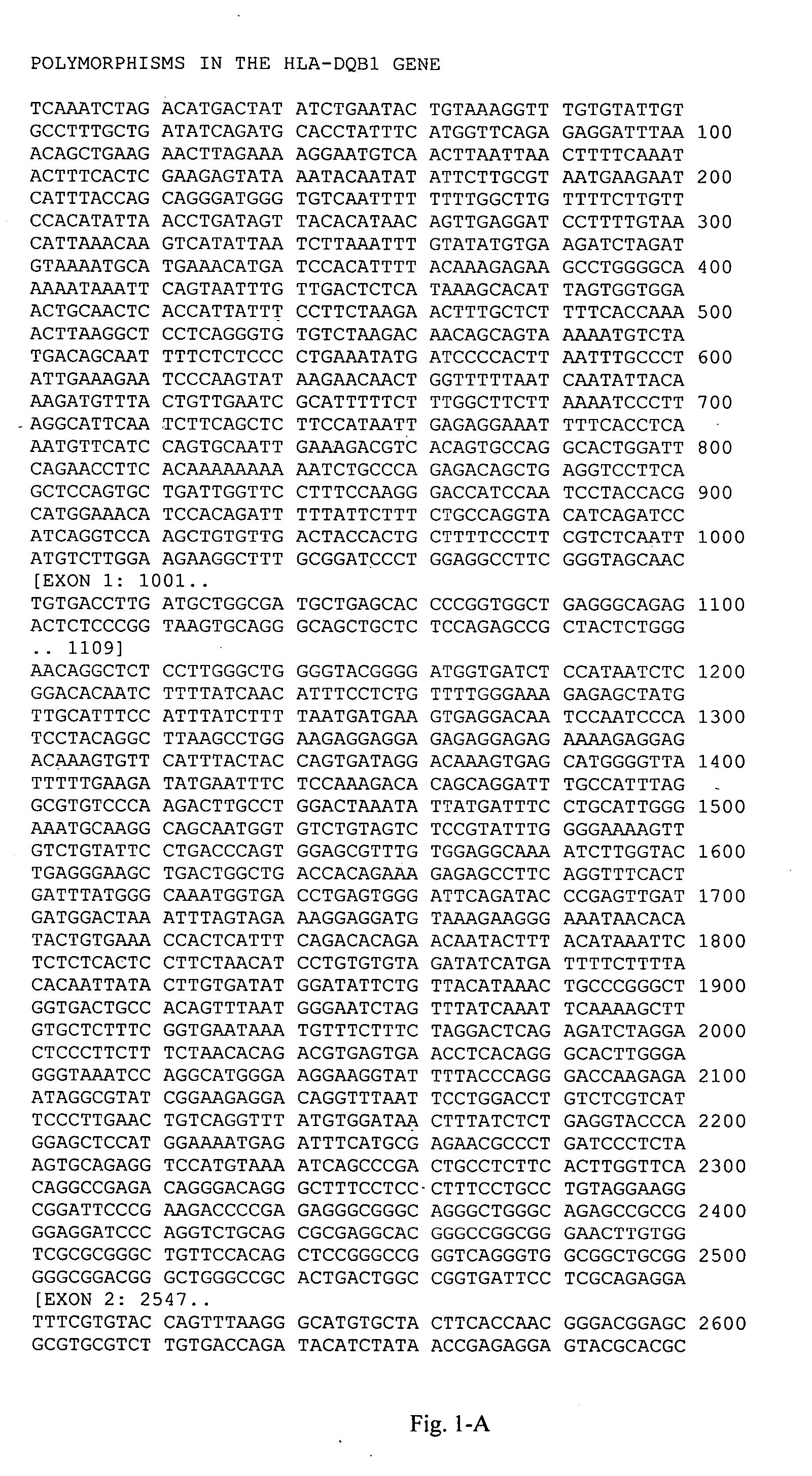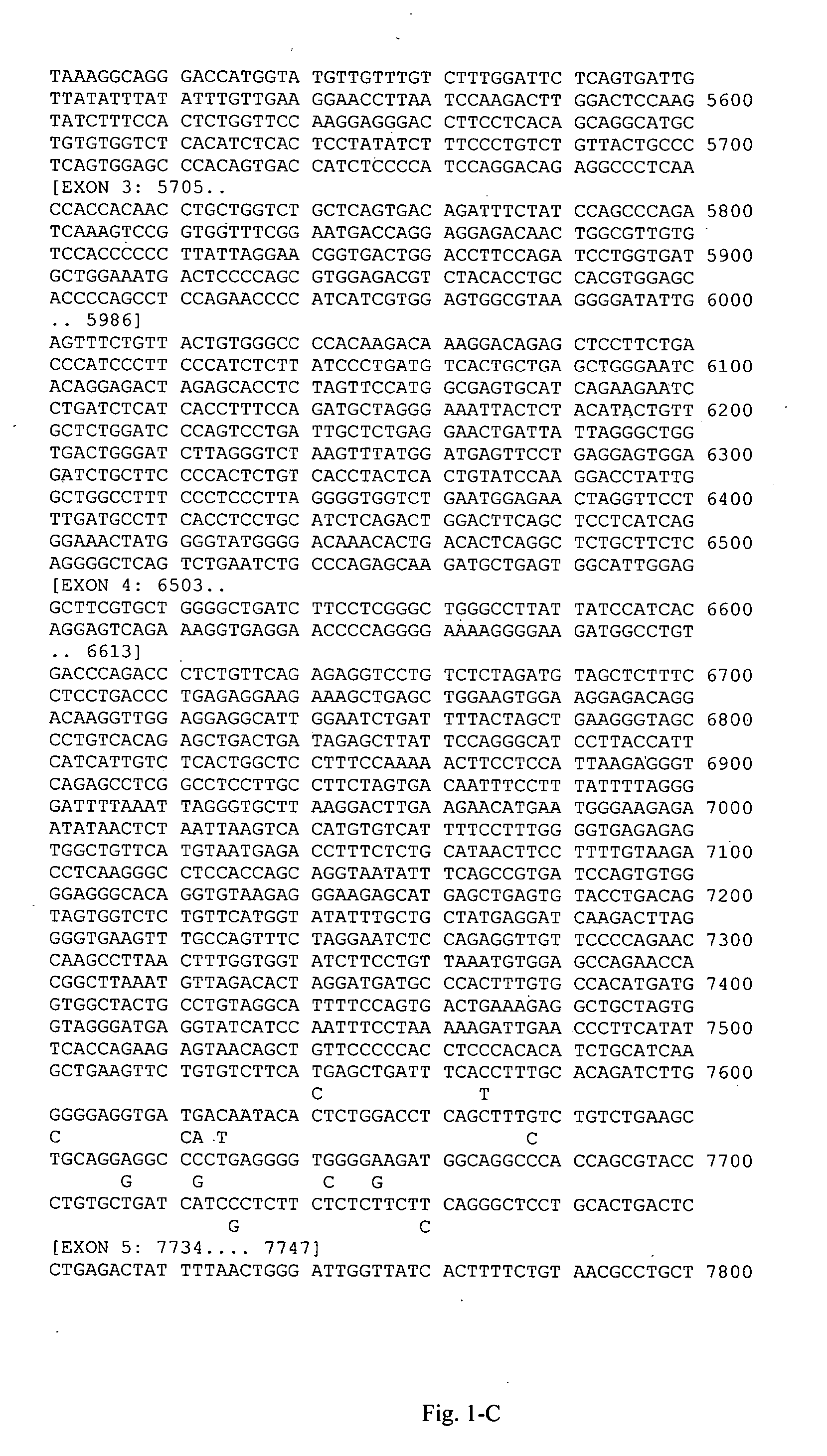Genetic markers in the HLA-DQBI gene associated with an adverse hematological response to drugs
- Summary
- Abstract
- Description
- Claims
- Application Information
AI Technical Summary
Benefits of technology
Problems solved by technology
Method used
Image
Examples
example 1
[0119] This example illustrates the inclusion and exclusion criteria in a case-control study to detect genetic markers associated with clozapine-induced agranulocytosis. The inclusion criteria for the cases were (1) an age of 18-75, (2) a diagnosis of agranulocytosis (absolute neutrophil count of less than 500 / mm3) during treatment with clozapine, and (3) a discontinuance of treatment with clozapine at the time of the diagnosis. The inclusion criteria for the controls were (1) an age of 18-75 and (2) treatment with at least 250 mg of clozapine for at least twelve months without a reduction in white blood cell count to less than 3000 / mm3 or a reduction in absolute neutrophil count to less than 1500 / mm3. The exclusion criteria for both cases and controls were (I) current enrollment in an investigational drug study, (2) compromised or suppressed immunity, and (3) known bone marrow disease. The covariates were age, gender, and ethnicity. The total numbers for the study were 33 cases (28...
example 2
[0120] This example illustrates genotyping of the study group for the 21 HLA-DQB1 polymorphic sites selected by the inventors herein for analysis. Genomic DNA samples were isolated from blood samples obtained from each individual and amplified target regions containing the polymorphic sites in Table A-3 (Appendix A) were sequenced to determine the study subjects' genotypes at these polymorphic sites. Tailed (Universal M13 Forward and Reverse) PCR primers were designed using the sequence of SEQ ID NO:1. Amplified PCR products were sequenced using Applied Biosystems' Big Dye® Terminator v 3.1 cycle sequencing kit according to manufacturer's instructions. The reaction products were then electrophoresed using an Applied Biosystems 3700 or 3730×1 DNA analyzer. Polymorphisms were identified using the Polyphred program, and confirmed by visual inspection.
example 3
[0121] This example illustrates the deduction of markers from the HLA-DQB1 genotyping data generated in Example 2.
[0122] Haplotypes were estimated from the unphased genotypes using a computer-implemented algorithm for assigning haplotypes to unrelated individuals in a population sample, essentially as described in WO 01 / 80156 (Genaissance Pharmaceuticals, Inc., New Haven, Conn.). In this method, haplotypes are assigned directly from individuals who are homozygous at all sites or heterozygous at no more than one of the variable sites. This list of haplotypes is then used to deconvolute the unphased genotypes in the remaining (multiply heterozygous) individuals.
[0123] A quality control analysis was performed on the deduced haplotypes, which included analysis of the frequencies of the haplotypes and individual SNPs therein for compliance with principles of Hardy-Weinberg equilibrium.
PUM
| Property | Measurement | Unit |
|---|---|---|
| Current | aaaaa | aaaaa |
| Electrical resistance | aaaaa | aaaaa |
| Toxicity | aaaaa | aaaaa |
Abstract
Description
Claims
Application Information
 Login to View More
Login to View More - R&D
- Intellectual Property
- Life Sciences
- Materials
- Tech Scout
- Unparalleled Data Quality
- Higher Quality Content
- 60% Fewer Hallucinations
Browse by: Latest US Patents, China's latest patents, Technical Efficacy Thesaurus, Application Domain, Technology Topic, Popular Technical Reports.
© 2025 PatSnap. All rights reserved.Legal|Privacy policy|Modern Slavery Act Transparency Statement|Sitemap|About US| Contact US: help@patsnap.com



